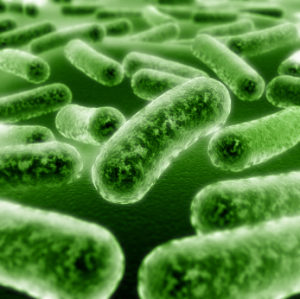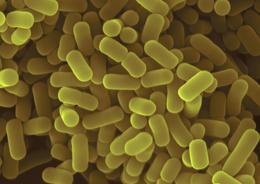 Could certain beneficial bacteria (probiotics) help prevent or deal with infections in burn wounds? Infection of burn wounds are a common complication and can even result in sepsis and death. This can occur even with the use of topical antibiotics (creams, gels) and antibiotics. The following study examined the use of the probiotic Lactobacillus plantarum on burn wounds in mice, and found that it had excellent results in dealing with the pathogenic bacteria Pseudomonas aeruginosa. The researchers (from the University of Pittsburgh Medical Center) weren't sure exactly how the L. plantarum worked against the pathogenic bacteria, but it worked. They were enthusiastic about probiotics being used in the future in burn wound treatment and called it local probiotic bacteriotherapy.
Could certain beneficial bacteria (probiotics) help prevent or deal with infections in burn wounds? Infection of burn wounds are a common complication and can even result in sepsis and death. This can occur even with the use of topical antibiotics (creams, gels) and antibiotics. The following study examined the use of the probiotic Lactobacillus plantarum on burn wounds in mice, and found that it had excellent results in dealing with the pathogenic bacteria Pseudomonas aeruginosa. The researchers (from the University of Pittsburgh Medical Center) weren't sure exactly how the L. plantarum worked against the pathogenic bacteria, but it worked. They were enthusiastic about probiotics being used in the future in burn wound treatment and called it local probiotic bacteriotherapy.
The pathogenic bacteria Pseudomonas aeruginosa is frequently involved with burn wound complications.The frequent use of antibiotics has led to the development of many multi-drug resistant strains. The bacteria also frequently develops biofilms, which are very hard to treat. Biofilms are communities of bacteria sticking to one another and coated with a protective slime. Thus a probiotic alternative to antibiotics would be very desirable in the treatment of wounds, especially if it can deal with the most common pathogenic bacteria and suppress biofilm formation or eliminate them.
Lactobacillus plantarum works not only against Pseudomonas aeruginosa, but also against other kinds of pathogenic bacteria such as Escherichia coli. The following study builds on an earlier study that applied Lactobacillus plantarum on human burn wounds (which is described in the last paragraph below). Excerpts from a research article by A. Argenta et al in PLOS ONE:
OBJECTIVE: To determine if local prophylactic application of probiotic bacteria to burn wounds will prevent death in a mouse model of burn wound sepsis. BACKGROUND: Infection remains the most common complication after burn injury and can result in sepsis and death, despite the use of topical and systemic antibiotics. Pseudomonas aeruginosa is a frequently implicated pathogen. Local application of probiotics directly to burn wounds is an attractive novel intervention that avoids the pitfalls of standard antibiotic therapies.
METHODS: A burn-sepsis model was established using a sub-eschar injection of bioluminescent P. aeruginosa; infection was tracked using a charge-coupled camera. Full-thickness burn injuries were placed on the dorsums of adult mice; the injured sites were then treated with vehicle (burn wound control), probiotics (Lactobacillus plantarum only), pathogenic bacteria (Pseudomonas aeruginosa only), or probiotics plus pathogen (Lactobacillus plus Pseudomonas). Animals were monitored until death/moribundity or for one week, then sacrificed. Harvested tissues were subjected to imaging and molecular assays.
RESULTS: Control and probiotic-only animals showed no mortality (100% survival) at one week. Pseudomonas-only animals showed > 90% mortality within 40 hours of infection. In contrast, animals treated with probiotics plus Pseudomonas showed less than 10% mortality. Use of bioluminescent Pseudomonas bacteria demonstrated that probiotic therapy inhibited septicemic accumulation of the pathogen in remote organs. In addition, probiotic therapy successfully suppressed the infection-dependent induction of TNF-α and interleukins 6 and 10 in the liver. CONCLUSION: Local probiotic therapy shows great potential as a valuable adjunct in the management of complicated burn injury.
Infection following burn injury remains the most common complication in burn wound patients of all age groups and is the most cited reason for mortality, accounting for up to 60–75% of burn related deaths....Burn wounds, classically considered to be sterile immediately upon injury, become colonized and infected within one week after insult, often while the patient is under direct hospital care.... It has also been recently recognized that numerous bacteria (and fungi) exist within burn wounds in the form of biofilms .... they are highly resistant to both conventional antibiotics and to natural host immune responses, as well as being recalcitrant to detection by standard microbiological culture.
One of the most frequently implicated pathogens in infection-related burn complications is Pseudomonas aeruginosa. Part of normal gut flora, P. aeruginosa is also prevalent in nature and has been identified on many hospital surfaces,....Because P. aeruginosa adapts rapidly, widespread and sometimes indiscriminate use of antibiotics has led to multi-drug resistant strains. Moreover, P. aeruginosa is well-known to be capable of biofilm formation, which further limits effectiveness of conventional antibiotic therapy.
Our results clearly indicate that local application of probiotic bacteria can be effective in reducing mortality from burn wound infection and can successfully suppress the systemic hyperinflammatory response such an infection typically provokes. It appears therefore that Lactobacillus is somehow able to contravene against the normally invasive Pseudomonal biology. The mechanisms by which this occurs are as yet unclear, but include several possibilities.
Furthermore, one study examined 56 burn patients, half of whom received oral probiotics [Lactobacillus acidophilus and Lactobacillus casei] half of whom did not. The investigators noted significantly fewer deaths in the treated group among patients with large (41–70%) total body surface area (TBSA) burns, and suggested that probiotic food additives may be clinically beneficial in these patients [35] It is unclear whether local probiotic therapy to the wound as employed here would confer a similar benefit versus gut-derived pathogens, but given that the probiotic bacteria themselves appear to translocate it is possible that it could be used in combination with oral therapy.
Locally applied probiotic bacteriotherapy offers an attractive if counterintuitive means to address the problem of burn wound infection. Probiotic bacteria may be active against a range of pathogens simultaneously, including drug-resistant organisms. They have demonstrated activity against fungal pathogens as well, for example, in their use as a treatment of Candidal vulvovaginitis [43]. They are unlikely to facilitate emerging antibiotic resistance and would be potentially effective even against pathogens in biofilm configuration.... They are inexpensive and could be easily applied topically to a burn injury site.
Thus far, the use of topical probiotics in burn patients is limited to a single report. Peral et al. applied topical L. plantarum soaked into gauze sponges to a cohort of second and third degree burn injured patients, divided into early and late treatment groups, and compared outcomes to a similar cohort of patients treated with silver sulfadiazine cream [45]. No systemic antibiotics were used, and the majority of patients had TBSA burns of <15%. The numbers of patients were too small to achieve statistical significance, but the investigators found little to no difference in the two cohorts overall in the rate of healing or in the bacterial counts in the healing wounds on subsequent biopsy. Importantly, no adverse outcome occurred in the 38 patients (with varying depth and time of injury) that could be related to the use of Lactobacillus, including no difference in subsequent skin graft take. These extremely preliminary data give promise that an appropriate regimen of local probiotic bacteriotherapy for burn injured patients can be safe and at least as effective as silver sulfadiazine. [The 2009 Peral et al study]
 Lactobacillus plantarum Credit: Nature
Lactobacillus plantarum Credit: Nature
